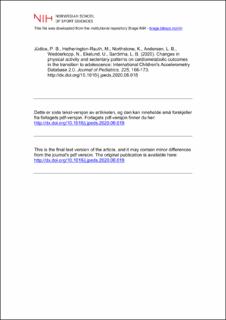| dc.contributor.author | Júdice, Pedro B. | |
| dc.contributor.author | Hetherington-Rauth, Megan | |
| dc.contributor.author | Northstone, Kate | |
| dc.contributor.author | Andersen, Lars Bo | |
| dc.contributor.author | Wedderkopp, Niels | |
| dc.contributor.author | Ekelund, Ulf | |
| dc.contributor.author | Sardinha, Luís B. | |
| dc.date.accessioned | 2021-06-07T07:25:30Z | |
| dc.date.available | 2021-06-07T07:25:30Z | |
| dc.date.created | 2020-11-02T17:16:34Z | |
| dc.date.issued | 2020 | |
| dc.identifier.citation | Journal of Pediatrics. 2020, 225(October 2020),166-173. | en_US |
| dc.identifier.issn | 0022-3476 | |
| dc.identifier.uri | https://hdl.handle.net/11250/2758068 | |
| dc.description | Dette er siste tekst-versjon av artikkelen, og den kan inneholde små forskjeller fra forlagets pdf-versjon. Forlagets pdf-versjon finner du her: http://dx.doi.org/10.1016/j.jpeds.2020.06.018 / This is the final text version of the article, and it may contain minor differences from the journal's pdf version. The original publication is available here: http://dx.doi.org/10.1016/j.jpeds.2020.06.018 | en_US |
| dc.description.abstract | Objective: To examine the associations of changes in physical activity and sedentary patterns with changes in cardiometabolic outcomes from childhood to adolescence.
Study design: Youth from the International Children's Accelerometry Database (n = 1088; 55% girls), aged 8-13 years and followed for ∼4 years, were used in this analysis. Hip-mounted accelerometers were used and all physical activity intensities were expressed as the % of total wear-time. Sedentary time was separated into time spent in bouts <10 minutes and ≥10 minutes. A composite z score for cardiometabolic risk (CMR score) was computed by summing the standardized values for systolic and diastolic blood pressure, triglycerides (TG), low-density lipoprotein cholesterol (LDL-c), and the inverse high-density lipoprotein cholesterol. Multivariate analyses were performed using adjusted linear regression models.
Results: Increase in sedentary time was unfavorably associated with changes in CMR score (β = 0.021; CI 0.004-0.037), TG (β = 0.003; CI 0.001-0.005), and diastolic blood pressure (β = 0.068; CI 0.009-0.128). Decrease in moderate-to-vigorous physical activity was unfavorably associated with changes in LDL-c (β = −0.009; CI −0.017 to −0.001) and TG (β = −0.007; CI −0.013 to −0.001). Increase in ≥10 minutes sedentary time was unfavorably associated with changes in CMR score (β = 0.017; CI 0.004-0.030), LDL-c (β = 0.003; CI 0.000-0.005), and TG (β = 0.003; CI 0.000-0.004). Decrease in light-intensity physical activity was unfavorably associated with changes in CMR score (β = −0.020; CI = −0.040 to 0.000).
Conclusions: More physical activity and less prolonged sedentary time are beneficial for cardiometabolic health in youth transitioning to adolescence. | |
| dc.language.iso | eng | en_US |
| dc.subject | moderate-to-vigorous physical activity | en_US |
| dc.subject | light intensity physical activity | en_US |
| dc.subject | sedentary behavior | en_US |
| dc.subject | longitudinal | en_US |
| dc.subject | LDL-c | en_US |
| dc.subject | triglycerides | en_US |
| dc.subject | youth | en_US |
| dc.title | Changes in physical activity and sedentary patterns on cardiometabolic outcomes in the transition to adolescence: International Children's Accelerometry Database 2.0 | en_US |
| dc.type | Peer reviewed | en_US |
| dc.type | Journal article | en_US |
| dc.description.version | acceptedVersion | en_US |
| dc.source.pagenumber | 166-173 | en_US |
| dc.source.volume | 225 | en_US |
| dc.source.journal | Journal of Pediatrics | en_US |
| dc.identifier.doi | 10.1016/j.jpeds.2020.06.018 | |
| dc.identifier.cristin | 1844265 | |
| dc.description.localcode | Institutt for idrettsmedisinske fag / Department of Sports Medicine | en_US |
| cristin.ispublished | true | |
| cristin.fulltext | postprint | |
| cristin.qualitycode | 2 | |
